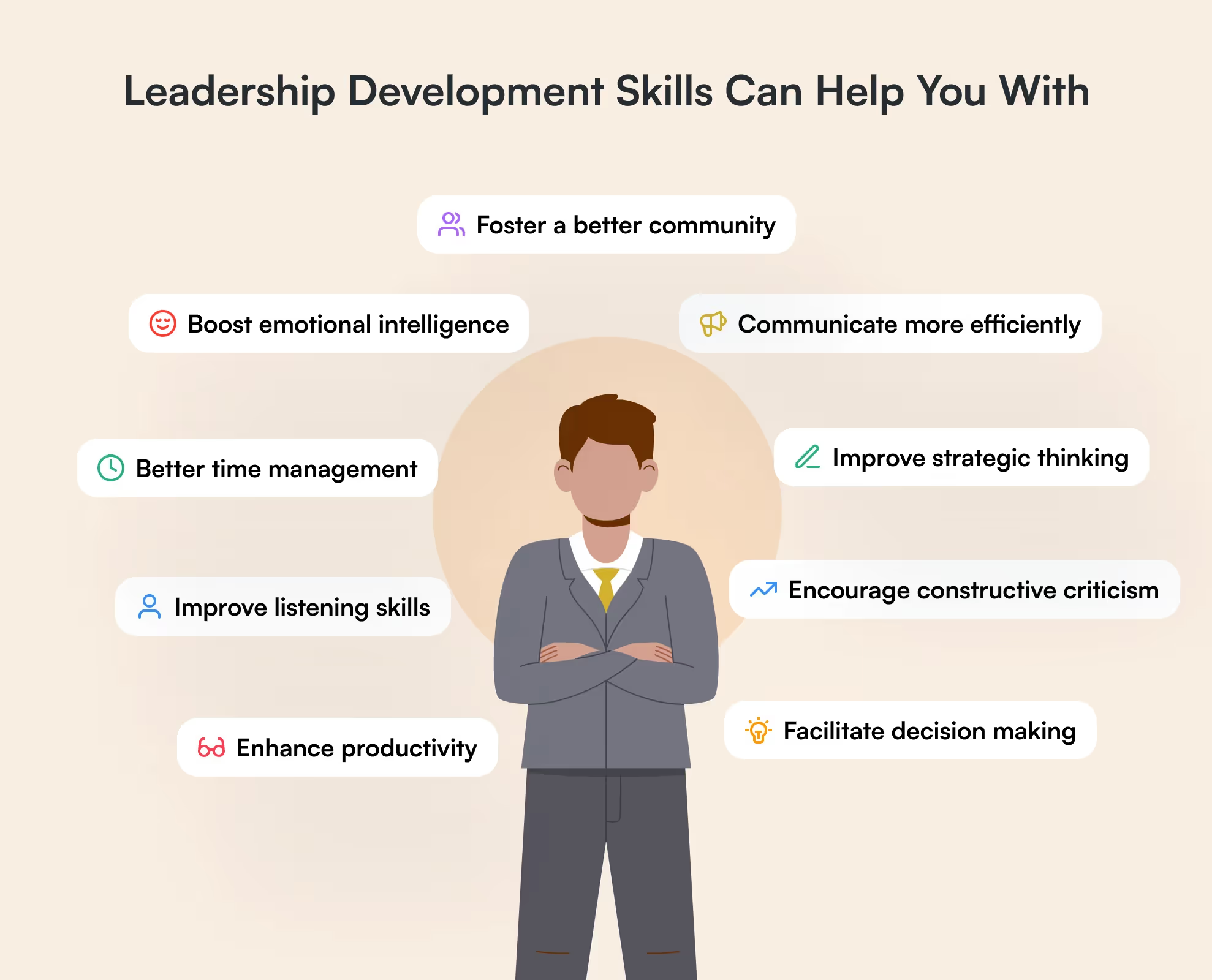The business world is highly competitive, which makes having effective leadership particularly important. With effective leadership, your company can foster an inclusive and innovative working environment that drives growth.
Building an accommodating culture can benefit your business in several ways. Having a desirable company culture can help you attract and retain top talent from around the world, as around 46% of job seekers cite workplace culture as being a deciding factor when sending out job applications.
Setting leadership development goals for a performance review can help your company in a number of ways. These goals can help you facilitate a better working environment, improve employee development, and increase productivity. Here are a few leadership performance review examples.
What is a Leadership Goal?
A leadership goal is an objective or target outcome that’s meant to improve your skills as a leader in a demonstrable way. These are typically used to increase effectiveness and drive professional growth from management. Leadership goals can be short or long-term objectives, though the end result must be an attainable and realistically achievable goal.

Leadership development skills can include several areas and help you:
- Communicate more efficiently with your employees
- Foster a better sense of community among your team
- Boost emotional intelligence to better connect with others
- Establish and elevate active listening skills
- Encourage constructive criticism and be receptive
- Improve strategic thinking
- Manage your time better
- Facilitate decision making
- Enhance productivity
When setting leadership goals for yourself or other team leaders, it’s important to be honest with yourself to appropriately develop areas of weakness. This can also help you ensure you’re working on skills that can benefit the specific needs of the company. In fact, the ability to reskill or up-skill is a must-have for employees in 2023 to remain competitive in the current labor market.
Leaders should always be looking for ways to improve their own abilities and create a positive working environment. Setting distinct goals can help you develop your team and advance your career. This approach in itself is a crucial leadership skill, as you will have the ability to assess your strengths and weaknesses, and then make a plan for positive change.
How Do You Set Leadership Development Goals?
There is no universal approach when it comes to setting goals to develop or hone leadership skills.
It’s important to customize your approach based on your unique skill set to get the best results for the business. Seeking feedback from your peers can help you gain a deeper understanding of your strengths and weaknesses.
When setting leadership goals, you should also have a specific plan for how you can achieve these developmental objectives. There are certain steps you can take to set yourself up well, and ensuring your goals are SMART can help you achieve success and advance your career.
Considering setting a SMART goal? Here is everything you need to know, so you can establish and work towards future SMART goals with ease!

Specific
A successful SMART leadership goal should have a defined outcome. As a business leader, you should have a clear understanding of what your goal is, why you need to develop it, and how you can achieve the objective.
This can help you and your team members avoid any potential confusion throughout the process.
For example, if your goal is to improve communication or build relationships with your team, you need to have an understanding of what’s required to actually achieve this.
Implementing a policy where you set aside an amount of time for weekly meetings with team members is a more precise goal that can help you reach the desired outcome.
Measurable
In addition to having a clearly defined and precise outcome, leadership development goals need to be measurable and quantifiable.
This means you must be able to track the progress of the goal from start to finish and clearly understand when the goal has been accomplished.
Examples can include increasing revenue by a certain amount or saving on certain employment costs.
Achievable
A smart leadership goal should be clearly defined and have measurable milestones to track progress, but it should also be realistic and attainable. This includes setting parameters that will enable you to succeed.
For example, instead of setting ambitious goals for improving your communication with team members, you could set a goal that can be achieved in a timely manner depending on the context.
This can include scheduling meetings with all teammates or taking external courses to sharpen your collaborative skills.
Relevant
Goals for leaders should align with their role in the company and clearly connect to the project or business objectives.
These tasks are reasonable, realistic, and have defined results that demonstrate the value of the task. It’s worth examining what the task is and how achieving it can benefit the company or your team.
For example, building better relationships with your team can be relevant when growing your business for various reasons. This can create a better work environment, foster collaboration among different departments, and improve productivity.
It could also lead to higher job satisfaction and employee retention.
Time Bound
Smart Leadership goals should be objectively achievable and have a specific timeframe or deadline to reach the desired outcome.
This can help you stay organized and motivated to complete the task. It can also help you break down the whole process into smaller and more manageable milestones.
For example, this can include implementing a policy for regular meetings by a certain date if you want to improve communication.
Why Are Leadership Development Goals Important for Performance Reviews?
Goals for leaders are important for reviewing employee performance in many ways. Because these goals have quantifiable and relevant objectives, leaders can hold themselves accountable and identify areas where they can improve. This can help boost morale and promote fairness with team members.
Additionally, SMART leadership goals are beneficial to companies if they’re aligned with the company’s objectives. When leadership goals and business objectives are strategically aligned, employees tend to feel better about performance management.
Employees who feel their companies have effective management systems are generally more productive than unhappy workers.
A performance review is a formal assessment of an employee’s overall performance, and the manager often offers feedback on how to continue their career development.
These reviews give workers the chance to receive constructive advice and can help facilitate better communication between leaders and their team members.
Five Examples of Leadership Goals for a Performance Review
Now that you have a better understanding of what a leadership goal is and how you can set achievable objectives, you might be looking for some specific examples of how you can further develop important skills.
To help you stay on track, we recommend finding a pen and paper, so that you can write leadership development goals down and truly manifest your long-term improvements.
Example 1: Build Relationships With Each Team Member and Boost Emotional Intelligence
Having clear and effective communication from leadership teams is vital for facilitating growth, establishing a good working culture and creating an overall positive work environment.
This includes giving helpful feedback and building relationships with your team members. By learning more about your workers, you can get a better understanding of their specific strengths and weaknesses.
Additionally, many successful leaders practice active listening with their team members. This means giving your entire attention in conversations to digest and understand what’s being said, leading to more productive communication and improved engagement.
Having the ability to acknowledge these areas of growth and make a plan to address each one can help to establish a higher level of emotional intelligence.
To reach this personal development goal, you can follow the SMART system to help you stay on track. For example:
- S: Improve communication by meeting regularly with teammates
- M: Schedule meetings with each team member at least once per month
- A: Allocate time and consider all logistical problems, such as different time zones
- R: By improving communication with your team, you can strengthen working relationships
- T: Setting a six-month timeline for completion with identifiable checkpoints to monitor progress
Communicating clearly with your team members is especially important with remote working arrangements becoming more common. Many companies now have employees in various countries around the world, so leaders should set goals to be more inclusive.
While this gives businesses access to a more diverse talent pool, it can also pose some potential challenges for leaders, such as cultural differences or language barriers.
Through effective communication and a continued effort to boost your emotional intelligence, you can enhance collaboration and foster a more inclusive environment in cross-border workplaces.
Example 2: Build a Dynamic Team
Fostering a friendly working environment that values teamwork should be another SMART goal for leaders. Companies tend to perform better when they have a diverse team with dynamic skill sets, and effective team building can lead to better productivity, innovation, and morale.
A good leader should be able to build a balanced team and identify the correct employee for a job. This means that leaders should actively try to develop the ability to evaluate if a potential worker can successfully achieve the desired outcome in that role.
By knowing your coworkers and understanding how to build a more versatile team, you can know when to promote internally or hire externally.
Building a dynamic team is an essential goal, but it’s also vague. To have a better chance at achieving success, the leadership development goal should define what aspects of your team-building could be better.
A SMART goal for building a better team could be:
- S: Foster a more inclusive and diverse work environment
- M: Tracking measurable metrics, such as team satisfaction scores or track the employee turnover rate
- A: Taking realistic steps to improve a single aspect of your team’s dynamics, such as actively hiring employees from different backgrounds
- R: Ensure that building a dynamic team that fosters inclusivity aligns with the business’s goals and how it can improve employee productivity
- T: Improve team satisfaction scores by the end of the year while tracking progress at various points
Example 3: Boost Your Leadership Skills by Being a Better Coach
In addition to building teams and strengthening relationships with your coworkers, quality leaders must also place an emphasis on developing other people’s skills.
Not only can this help improve the company’s performance, it can help your team grow and advance in their careers.
By gaining deeper insights into your staff, you can create a more effective approach to leadership development plans – designed to help each worker achieve success and gain new skills.
Giving constructive feedback and sharing your expertise can also facilitate better communication and employee retention.
For this SMART leadership goal, you could:
- S: Define what specific area you want to improve, such as helping team members set or achieve goals
- M: Measure how you can track this, such as monitoring goal achievement rates
- A: Figure out how you can actually achieve this goal, such as setting regular training sessions for your staff
- R: Examine how becoming a better coach aligns with leadership goals and how it can help the company become more successful, such as delivering better performance
- T: Decide when you want to see improvements in your coaching abilities by and measure periodically each month
Example 4: Improve Time Management
Finding ways to improve your time management is another important goal for leaders to consider.
Leaders generally have to manage a range of different responsibilities and priorities while still ensuring that their team remains productive.
By figuring out how to manage your time more efficiently, you can ensure your team accomplishes more work in less time.
This gives you more focus and energy to put into advancing your skills, coaching your team, providing constructive feedback, and making the correct decisions to help your company grow.
To achieve this SMART leadership goal, you could:
- S: Decide what specific area you can improve on, such as eliminating tasks that aren’t productive
- M: To quantify the goal, you could track the time spent on all tasks and reduce the amount of time spent on tasks that aren’t priorities
- A: Establish how you can realistically achieve the goal by breaking it down and focus on improving your time management with smaller goals
- R: With improved time management, your team can be more productive and have a better working environment to achieve success
- T: Improve your time management by measuring productivity increases at the end of the year with weekly progress reports
Example 5: Have a Growth Mindset
Business leaders should prioritize setting development goals that allow them to become more flexible and adaptable. Being more open-minded can help your company build a versatile team with a diverse range of perspectives and skill sets to help the business thrive.
Inevitably, leadership staff will face setbacks or shortcomings. It’s important to recognize mistakes or challenges as an opportunity to grow and develop new skills to help your team.
This can help you implement a culture that values innovation. Additionally, by gaining a deeper understanding of your limitations, you can effectively delegate tasks and manage your time more effectively.
Having a growth mindset can also help you take constructive criticism and make relevant improvements, which can help you advance in your own career.
Receiving constructive feedback from your superiors is a great example of a leadership performance review because it lets you know what you can build on.
To achieve this SMART goal, you might:
- S: For example, you might seek to improve your ability to learn from constructive criticism
- M: To quantify your leadership development goal, you might want to increase the number of employees who give feedback by a percentage
- A: Figure out how you can actually take steps to achieve a growth mindset in your role (for example, implement meetings or a forum for suggestions)
- R: By achieving a growth mindset, you can benefit your business by being more adaptable and open to new ideas
- T: Measure your quantifiable results over a year after each quarter

Hire Talent From Around the World with Borderless
Borderless can help you attract top talent from around the world and hire employees from over 170 different countries.
Our Service Solutions at Borderless
We offer various EOR services, including payroll, taxation, and more, allowing you to spend more time focusing on your career development and coaching your team. Talk to our team of global experts to see what we can do for you.
Or, if you’re just looking for information about leadership development goals, creating a SMART goal, finding resources for professional development, and resources that can help you learn how to better manage your team, check out our Insights page to learn more!
Disclaimer
Borderless does not provide legal services or legal advice to anyone. This includes customers, contractors, employees, partners, and the general public.
We are not lawyers or paralegals. Please read our full disclaimer here.









